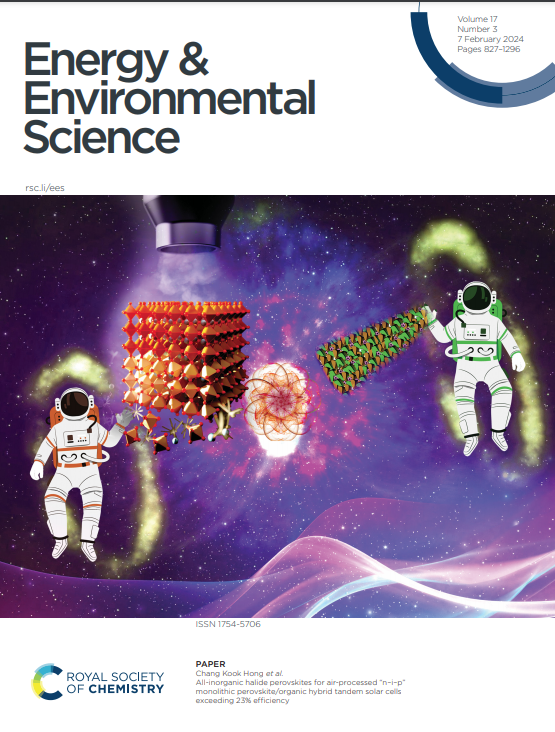Stabilizing doped Spiro-OMeTAD by organic molten salt for efficient and stable perovskite solar cells
IF 32.4
1区 材料科学
Q1 CHEMISTRY, MULTIDISCIPLINARY
引用次数: 0
Abstract
Bis(trifluoromethane)sulfonimide (LiTFSI) and 4-tert-butylpyridine (TBP) have been currently suggested to be irreplaceable in classic doped 2,2′,7,7′-tetrakis (N,N-di-p-methoxyphenylamine)-9,9′-spirobifluorene (Spiro-OMeTAD) for high-performance perovskite solar cells (PSCs). However, the stability of Spiro-OMeTAD was demonstrated to be seriously limited by the Li+ diffusion of LiTFSI and the volatilization of TBP. Here, we report an organic molten salt, Cyclohexylamine Trifluoroacetic acid (CYTFA), doping strategy to stabilize doped Spiro-OMeTAD for high-performance PSCs. We found the Li+ diffusion and the TBP volatilization were effectively suppressed through strong interaction by the dissociated CY+ and TFA- acting on TBP and Li+. Moreover, the CYTFA doped Spiro-OMeTAD exhibits an order of magnitude increase in hole mobility and matched energy levels with perovskite. As a result, a solar cell with a power-conversion efficiency of 25.80% was achieved with maintaining 96% and 80% of the initial efficiency for 500 hours at 55°C and 55% humidity and for 470 hours at the maximum power point, respectively.用有机熔盐稳定掺杂的螺-OMeTAD,实现高效稳定的过氧化物太阳能电池
双(三氟甲烷)磺酰亚胺(LiTFSI)和 4-叔丁基吡啶(TBP)目前被认为是经典的掺杂 2,2′,7,7′-四(N,N-二对甲氧基苯胺)-9,9′-螺二芴(Spiro-OMeTAD)高性能包晶体太阳能电池(PSCs)中不可替代的物质。然而,由于 LiTFSI 的 Li+ 扩散和 TBP 的挥发,Spiro-OMeTAD 的稳定性受到严重限制。在此,我们报告了一种有机熔盐--环己胺三氟乙酸(CYTFA)--的掺杂策略,以稳定用于高性能 PSC 的掺杂螺-OMeTAD。我们发现,通过解离的 CY+ 和 TFA- 对 TBP 和 Li+ 的强相互作用,Li+ 的扩散和 TBP 的挥发得到了有效抑制。此外,掺杂 CYTFA 的斯派罗-OMeTAD 的空穴迁移率提高了一个数量级,能级也与过氧化物相匹配。因此,太阳能电池的功率转换效率达到了 25.80%,在 55°C 和 55% 湿度条件下可维持 96% 和 80% 的初始效率 500 小时,在最大功率点条件下可维持 470 小时。
本文章由计算机程序翻译,如有差异,请以英文原文为准。
求助全文
约1分钟内获得全文
求助全文
来源期刊

Energy & Environmental Science
化学-工程:化工
CiteScore
50.50
自引率
2.20%
发文量
349
审稿时长
2.2 months
期刊介绍:
Energy & Environmental Science, a peer-reviewed scientific journal, publishes original research and review articles covering interdisciplinary topics in the (bio)chemical and (bio)physical sciences, as well as chemical engineering disciplines. Published monthly by the Royal Society of Chemistry (RSC), a not-for-profit publisher, Energy & Environmental Science is recognized as a leading journal. It boasts an impressive impact factor of 8.500 as of 2009, ranking 8th among 140 journals in the category "Chemistry, Multidisciplinary," second among 71 journals in "Energy & Fuels," second among 128 journals in "Engineering, Chemical," and first among 181 scientific journals in "Environmental Sciences."
Energy & Environmental Science publishes various types of articles, including Research Papers (original scientific work), Review Articles, Perspectives, and Minireviews (feature review-type articles of broad interest), Communications (original scientific work of an urgent nature), Opinions (personal, often speculative viewpoints or hypotheses on current topics), and Analysis Articles (in-depth examination of energy-related issues).
 求助内容:
求助内容: 应助结果提醒方式:
应助结果提醒方式:


